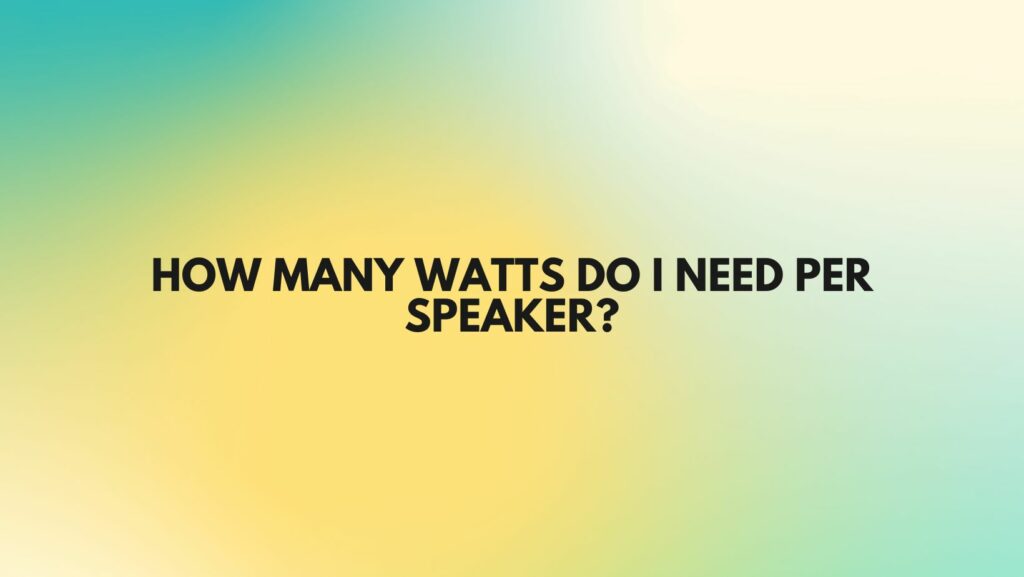Selecting the right number of watts per speaker is a critical decision when building an audio system, whether it’s for home entertainment, a car audio setup, or a professional sound reinforcement system. The wattage of your speakers plays a pivotal role in determining the volume and quality of the sound they produce. In this comprehensive article, we will explore the various factors that influence how many watts you need per speaker, and we’ll provide guidance for different applications.
Understanding Speaker Wattage
Before delving into the specifics of wattage requirements, it’s important to understand what speaker wattage represents. Wattage, measured in watts (W), is a unit of power that indicates how much electrical power a speaker can handle and convert into sound. In the context of speakers, two common wattage ratings are used:
- RMS (Root Mean Square) Power: This represents the continuous, stable power that a speaker can handle without distortion or damage. RMS power is a critical indicator of a speaker’s everyday performance.
- Peak Power: Peak power is the maximum short-term power a speaker can tolerate without failing. While it can be a useful reference, RMS power is more indicative of a speaker’s actual performance.
Factors Influencing Wattage Requirements
Determining the number of watts you need per speaker is influenced by several key factors:
- Sensitivity: Speaker sensitivity, typically measured in decibels (dB), signifies how efficiently a speaker converts electrical power into sound. A higher sensitivity rating means that a speaker can produce more sound for a given amount of power. When speakers have higher sensitivity, you require fewer watts to achieve a certain loudness level.
- Application: The intended use of the speakers is a crucial consideration. Different applications have distinct wattage requirements. Here are a few common applications:
- Home Audio: For a standard home audio setup, such as bookshelf or floor-standing speakers in a living room, 20-100 watts per speaker is usually sufficient.
- Car Audio: Car audio systems often have varied power requirements depending on the listening environment and personal preferences. In a car, you might need 10-100 watts per speaker.
- Live Sound and Professional Audio: Large venues, clubs, and live sound setups often demand speakers with significantly higher wattage per driver, sometimes ranging from 100 to 1000 watts per speaker, or even more.
- Room Size and Acoustics: The size and acoustic properties of the room or space where the speakers will be used can significantly impact wattage requirements. Larger rooms, open spaces, and areas with reflective surfaces may require more power to provide even coverage and maintain clarity.
- Listening Preferences: Your personal listening preferences are essential. If you enjoy listening to music at moderate volumes, you might not need high-wattage speakers. On the other hand, if you prefer to crank up the volume or enjoy bass-heavy music genres, you may require more power.
- Quality and Efficiency: The quality of the speakers themselves and their design can impact their ability to handle and efficiently use power. High-quality speakers with efficient design can deliver more sound per watt and maintain audio clarity even at higher volumes.
Practical Examples
To provide a clearer understanding of wattage requirements, here are some practical examples:
- Home Audio: If you’re setting up a home stereo system with bookshelf speakers in a small to medium-sized room, you might need 20-50 watts per channel per speaker. A stereo amplifier delivering 40-100 watts per channel should suffice.
- Car Audio: In a car, a standard setup might involve 25-75 watts per channel for each speaker. If you have a pair of car speakers rated at 50 watts RMS, you’d need an amplifier capable of delivering 50-150 watts per channel.
- Live Sound: In a professional sound reinforcement system for a medium-sized venue, speakers rated at 250-500 watts RMS might be appropriate. The amplifier driving them should provide similar wattage to ensure sufficient volume and clarity.
Conclusion
The number of watts you need per speaker is not a one-size-fits-all answer but rather depends on multiple factors, including speaker sensitivity, intended use, room size, personal preferences, and speaker quality. By considering these factors carefully, you can choose the appropriate wattage to ensure that your speakers deliver the desired level of loudness and audio quality for your specific application. Always remember that it’s better to have more wattage available than you need to avoid distortion and protect your speakers from being overdriven.


